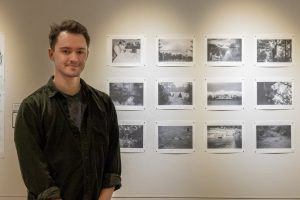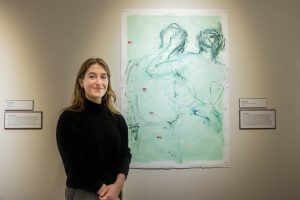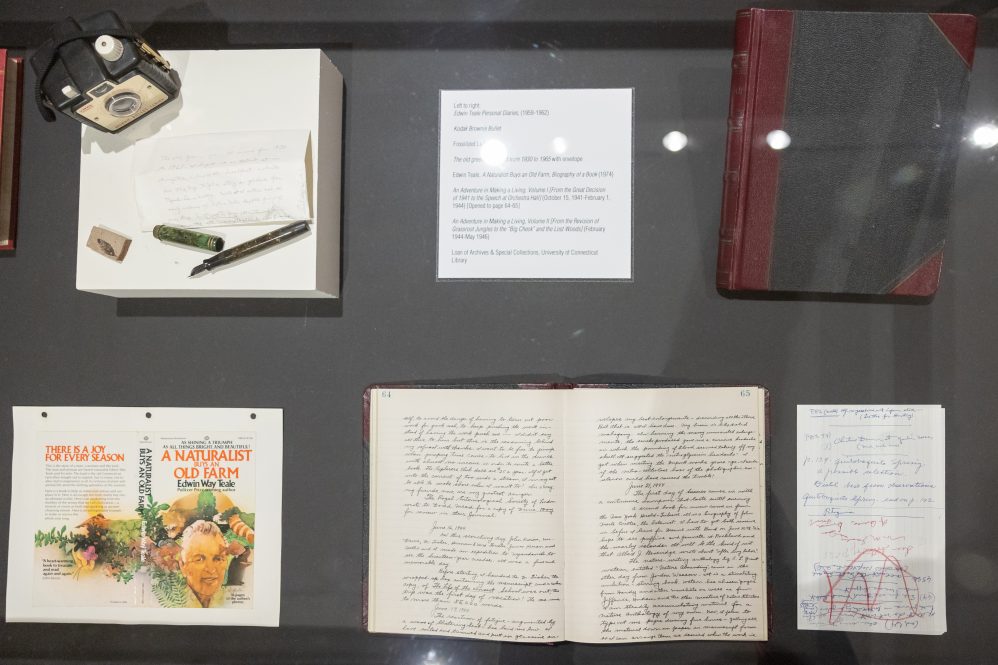Like so many sons seeking to emulate their fathers, young David Teale also was a photographer and author – albeit of smaller acclaim than the Pulitzer Prize-winning naturalist Edwin Way Teale.
And unlike his famous father’s work, David’s book, “Mr. Teale and His Pictures,” is held together with paper fasteners and features a construction paper cover with a black-and-white photo of Edwin that’s lifting at the edge where adhesive is giving way.
Even though the keepsake may have been for only family, close friends, or a teacher, that little red book caught the endearing eye of Noah Thompson ’24 (MFA), who describes the artifact that’s part of the Edwin Way Teale Papers in UConn Library’s Archives & Special Collections as “something so sweet.”

When he came upon the book, Thompson says he felt drawn to young David and driven to pour through his high school and summer camp journals from the 1930s and ’40s, along with his diary from just before he was drafted into World War II, to get a sense of the young man who was killed in action at 19.
“Then I found a bunch of negatives of David’s photographs,” Thompson says. “He never was able to bring his prints to life. I felt compelled to do that for him.”
The resulting work from Thompson, “Mr. Teale the Younger and His Pictures,” is part of the larger show, “Raid the Archive: Edwin Way Teale and New Works,” at the William Benton Museum of Art.
“Raid the Archive” is the culmination of photography professor Janet Pritchard’s fall Special Topics in Studio Art class, ART 5383, that looked to the Teale family for inspiration and the archives located in The Dodd Center for Human Rights for access.
Pritchard, who works in the art and art history department in the School of Fine Arts, says she was inspired by the 2019-20 exhibition, “Raid the Icebox Now,” at the RISD Museum in Providence, and started considering how to use the Teale collection at UConn and efforts of first-year MFA students who take the special topics class their first two semesters in the three-year program.
Since the class rotates instructors, Pritchard needed, first, to wait her turn. Then, she needed the Benton to have a gallery available. Archival staff needed to have enough free time to work with the students, and finally she needed a group of students up to the challenge.
“The students had never worked this way, so it was a big ask,” Pritchard says. “Not only had they never worked this way, but some of them are not oriented toward the natural world; they’re city people and this was foreign to them. For others, Teale was hard to connect with because he’s a ‘dead, white man.’ But one of the things I told them early on is, ‘Your job is to keep an open mind and find a point of connection, a way to engage. Follow your curiosity to do that and trust it.’”
Monica Hamilton ’25 (MFA) used Edwin Teale’s Kodak Brownie Bullet camera to take pictures at his former homestead in Hampton, Trail Wood, which the Connecticut Audubon Society now operates as a sanctuary.
Amira Brown ’25 (MFA) created a wall sculpture highlighting words from one of Edwin Teale’s book dedications to his wife, Nellie. The piece pops off the museum wall and states, “The longest journey of all.”
“When these students get to their last semester of their third year, they’ll have an MFA show at the Benton, and this group is going to be way ahead of others having taken this class,” Pritchard says. “Exhibiting is an artist’s performance; it’s where we strut our stuff, and our students don’t get to do that that much. They sometimes get here as graduate students and have very little experience hanging a show.”
So, not only did the class teach students how to use an archive and draw inspiration from the past for present work, it gave them the experience of curating a show – “how to pull pieces out and arrange them, how to write all the wall text to inform an audience, how to get the work framed and figure out where it is going to go,” Pritchard says.
During installation of the show over winter break, the students came in with a written plan thinking they knew where everything would go. Pritchard says they quickly realized they needed to readapt to whatever circumstance arose.
Hanieh Kashani ’25 (MFA) was home in Iran when her sculpture, “Ribbon Map, The Anatomy of a Journey,” was to be installed, Pritchard says. So, Mahsa Attaran ’25 (MFA) contacted her over video chat, and together the two worked together to get the installation to look just right.
“Finishing work is something they don’t often have a lot of experience with either,” Pritchard says. “How to frame it, how to present it, how to attach it to the wall, all those practical matters take thought and consideration and negotiation with the museum.”

Anna Schwartz ’25 (MFA) settled on the use of magnets to fasten her painting “Projective Verse (after Charles Olson)” to the wall.
“From the start of this project, Janet was clear that we were taking on a huge but exciting undertaking,” Schwartz says. “On the first day of class, she told us we had three months to put together a show of not just our own work, but also objects from the Teale collection. The weeks that followed served as a rich course in curating, research, and familiarizing ourselves with the history of our new surroundings in Connecticut.”
While Thompson, who’s a second-year student and took the class as an elective, was inspired by David Teale, Schwartz says she was fascinated by the relationship between husband and wife, Edwin and Nellie Teale.
“They worked in partnership. I read his diaries and his books on the actual nuts and bolts process of being a naturalist, and I found her interwoven throughout so much of it,” Schwartz says. “She was just as much of a researcher as he was. I see her in partnership with him even though he is the big name, and I think that is very much because of the time. She contributed so much. It feels like from his notes he was really aware of that.”
In her piece, Schwartz framed the two in partnership, showing them from behind, arm in arm, moving forward. The oil painting looks like graph paper, harkening to the meticulous notes Edwin Teale kept. Red squares on the painting mark the couple’s wedding anniversary, reminiscent of an actual marker in a notebook.
“It was really nice to work in the Dodd Center and see the things in the archives, items we have available to us all the time,” she says. “We have so much here at UConn in terms of resources. I knew a little bit about that, which is why I chose UConn, but you don’t fully understand what’s available until you’re here on campus.”
Thompson says his biggest takeaway from the class was learning to leave room for surprise.
“Once we got into the archives, I decided to let my mind wander. While it’s good to have a set idea going into an archive to do research, leave yourself open to surprise,” he advises. “Select a random box and go through it and see what happens.”
The biggest surprise for Schwartz was how quickly the show came together.
“I didn’t realize we could do this in three months, and I know that’s not common,” she says. “Normally, the Benton has shows planned one or two years out.”
Pritchard says she’s called on other collections on campus for class assignments over the years, but the Teale collection is something that never disappoints – especially since ongoing inspiration comes from The Edwin Way Teale Lecture Series put on by the Center for Environmental Sciences and Engineering at UConn’s Institute of the Environment.
“I’d love to do this again with another group,” she says. “The Teale collection is probably the richest singular resource we have on campus. And part of what is interesting about this collection and what is most important for the students’ engagement is what they can learn from his voice.”
Visit “Raid the Archive: Edwin Way Teale and New Works” at the William Benton Museum of Art through March 10.



